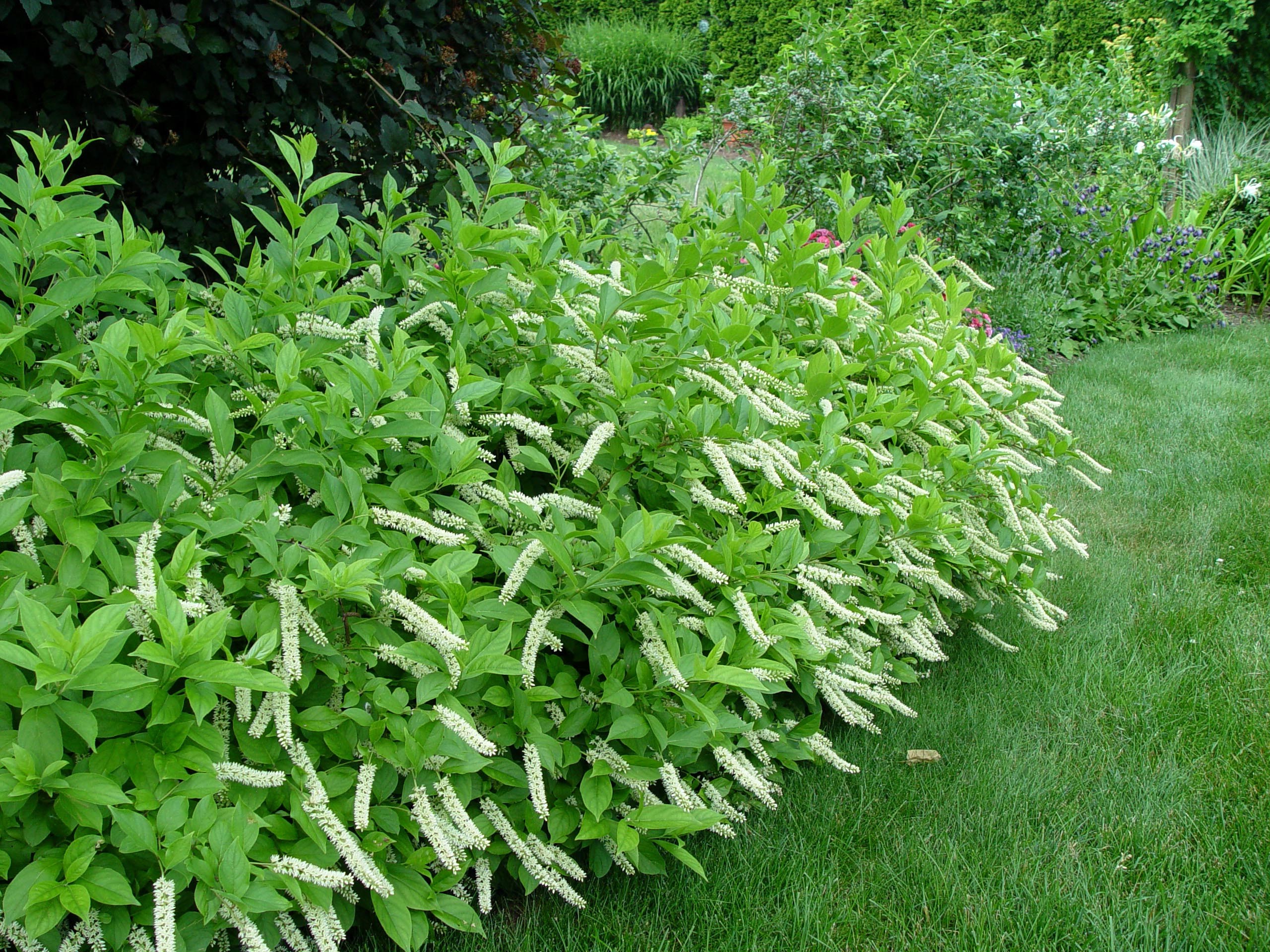Itea virginica: Virginia Sweetspire
 Latin name: Itea virginica
Latin name: Itea virginica
Common name: Virginia Sweetspire
Flowers: Fragrant, white, showy flowers that create a drooping raceme 3 to 6 inches long. Bloom in late spring to early summer12
Fruit: Small copper capsules arranged in drooping racemes. Showy, and edible during late summer to early fall12,13
Height & Width: 3- 5 ft H by 3-5 ft W12.
Type: Deciduous perennial shrub 16
Habit: Dense, well rounded, and arching 4
Wetland indicator category**: FACW & OBL 17
Texture: Medium 16
Growth rate: Slow to medium 16
Light: Part shade 4
Moisture: Medium, occasionally wet soil. Good drainage, and tolerant of standing water13,16
Soil*:Prefers high organic matter, and pH ranges between 6 – 813
Zones: 5-9 13
Origin: Southern United States 16
Ecosystem benefits: Long fragrant flowers attract butterflies and other pollinators. Fruit and seeds are food for small birds. The ability to grow in wet ponds, and marshes provides shelter for smaller mammals12,13.
Features: This native species offers multi season allure, with little maintenance. This plant accepts wide ranges of soil quality, and is tolerant to standing water and pests13,16. During spring and early summer, small white flowers are produced on long drooping racemes, to create a showy overall appearance12.These fragrant flowers also attract insects and pollinators13 In the fall, the racemes turn to copper capsules with edible seeds, that provide food for birds12. The foliage on this plant also offers attraction because the oval, dark green leaves turn various shades of red and gold during the fall13.
Siting: For year-round visual appeal, this dense and well-rounded shrub should be planted in a well shaded, and occasionally wet soil location13. Common ornamental landscape uses are as border shrubs, and hedges in large groups, because just one plant can become scraggly12. For a natural aesthetic, the advantage of water tolerance can be implemented in ponds, riverbanks, and marsh settings to act as a wildlife food source, and source of attraction during multiple seasons10,12.
Care: Plant so crown/root flare is visible at soil surface14. At planting, water the root ball daily with two gallons of water per inch of trunk diameter for two weeks, every other day for two months and then weekly until established. Modify water recommendations to reflect site drainage and rainfall. Apply 3” of mulch over the planted area. Do not allow mulch to touch the crown/trunk14.
Pests: Plants are relatively pest resistant if cultural preferences are met12.
This plant does not appear on the following invasive plant lists on 03/01/2022:
USDA SC Invasive Plant Species
SC Exotic Plant Pest Council
Author: Molly McKay
Image source: https://nathandewberrydotorg.wordpress.com/2014/09/05/virginia-sweetspire-itea-virginica/
Sources:
- Armitage, A. (2001). Armitage’s manual of annuals, biennials, and half-hardy perennials. Portland, OR: Timber Press.
- Armitage, A. (2006). Armitage’s native plants for North American gardens. Portland, Oregon: Timber Press.
- Armitage, A. (2008). Herbaceous perennial plants: A treatise on their identification, culture, and garden attributes. Athens, GA: University of Georgia.
- Clemson Cooperative Extension Home and Garden Information Center.(2011). Flowers fact sheets. Retrieved from http://www.clemson.edu/extension/hgic/plants/landscape/ flowers/
- Clemson Cooperative Extension Home and Garden Information Center.(2011). Groundcovers & vines fact sheets. Retrieved from http://www.clemson.edu/ extension/hgic/plants/landscape/groundcovers/
- Clemson Cooperative Extension Home and Garden Information Center.(2011). Trees. Retrieved from http://www.clemson.edu/extension/hgic/ plants/landscape/trees/
- Clemson Cooperative Extension Home and Garden Information Center.(2011). Shrubs. Retrieved from http://www.clemson.edu/extension/hgic/plants/landscape/shrubs/
- Dirr, M. A. (2009). Manual of woody landscape plants. Champaign, IL: Stipes Publishing.
- Gilman, E. F. (1997). Trees for urban and suburban landscapes. Albany, NY: Delmar Publishers.
- Lady Bird Johnson Wildflower Center University of Texas at Austin. (2012). Native plant information network. Retrieved from http://www.wildflower.org/explore/
- McMillan, P., Plant taxonomist Clemson University, personal communication.
- Missouri Botanical Garden Kemper Center for Home Gardening. Plant finder. Retrieved from http://www.mobot.org/gardeninghelp/plantfinder/Alpha.asp
- North Carolina State University (2005). Plant fact sheets. Retrieved from http://www.ces.ncsu.edu/depts/hort/consumer/factsheets/index.html
- Strother, E. V., Ham, D. L., Gilland, L. (2003) Urban tree species guide: Choosing the right tree for the right place. Columbia, SC: South Carolina Forestry Commission.
- University of Florida, IFAS Extension. (2011). Southern trees fact sheet. Retrieved from http://edis.ifas.ufl.edu/department_envhort-trees
- USDA . Plant profile. (n/d).Retrieved from http://plants.usda.gov/java/
- USDA. Plant wetland indicator status. (n/d). Retrieved from http://plants.usda.gov/wetland.html
- Vincent, E., Environmental horticulturist Clemson University, personal communication.
- Clemson Extension. Carolina Yards Plant Database. Retrieved from https://www.clemson.edu/extension/carolinayards/plant-database/index.htm
*Soil pH is determined using a professional soil test. Contact your Clemson University County Extension service for assistance www.clemson.edu/extension/. Click on “local offices”.
**2012 Plant Wetland Indicator categories (quantitative derived) http://plants.usda.gov/wetinfo.html
| Indicator Code | Indicator Status | Comment |
|---|---|---|
| OBL | Obligate Wetland | Almost always is a hydrophyte, rarely in uplands |
| FACW | Facultative Wetland | Usually is a hydrophyte but occasionally found in uplands |
| FAC | Facultative | Commonly occurs as either a hydrophyte or non-hydrophyte |
| FACU | Facultative Upland | Occasionally is a hydrophyte but usually occurs in uplands |
| UPL | Obligate Upland | Rarely is a hydrophyte, almost always in uplands |
